#balaban and katz
Text

Lobby window detail, Chicago Theater, August 2007
#chicago theater#chicago theatre#stained glass#movie theaters#theaters#theatres#movie palace#architecture#balaban and katz#chicago architecture#glasswork#lumix dmc-fz20#photographers on tumblr#bruce sharp#2007
4 notes
·
View notes
Text
The Riviera Theater, Uptown, Chicago
4746 N Racine Ave, Chicago, IL 60640
Opened Oct. 2, 1918
C.W. Rapp and George Rapp, architects
Balaban & Katz, original owners
Seating Capacity: 2,500
Jam Productions, current owners
Current use: Concert venue
Completed in 1917 by architects George and C.W. Rapp (Rapp & Rapp), it was built as a movie theater for the Balaban & Katz chain. Transformed into a private nightclub in 1986, the Riviera Theatre is now one of Chicago’s premier concert and special events venues.
Jam Productions website https://www.jamusa.com/venues/riviera-theatre


Broadway and Lawrence, Uptown


Two theaters: the Riviera and the Uptown
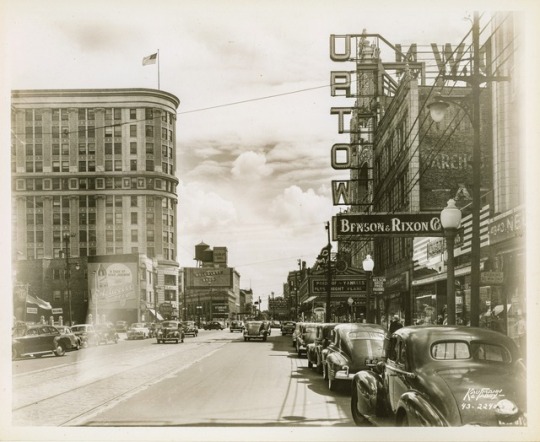

Photo on display in the Riviera lobby, showing original chandelier, now gone, and the box office, which remains

The Riviera Theatre was the largest and most ornate of the movie theatres of the Uptown neighborhood until the opening of the Uptown Theatre almost a decade later. Opened October 2, 1918 with Lina Cavalieri in “A Woman of Impulse”. Built at a cost of well over half a million dollars (delayed by almost two years due to World War I), this Rapp & Rapp-designed house located on N. Racine Avenue between Broadway and W. Lawrence Avenue, originally seated 2,600 and its building also featured eight storefronts and over 30 apartments.
Initially the Riviera Theatre was to have been operated by the Jones, Linick & Schaefer chain, which operated several Loop movie houses in the 1910’s and 1920’s such as the Orpheum Theatre, the Rialto Theatre, and the McVickers Theatre. However, the Riviera Theatre ended up becoming the second major theatre of the Balaban & Katz circuit, which at the time also included the Central Park Theatre, now regarded as Chicago’s first true ‘movie palace’.
Featuring movies accompanied by the orchestra of S. Leopold Kohl, the Riviera Theatre also featured “high class” musical acts on stage. It was initially equipped with a Barton theatre organ which was later replaced by a Wurlitzer organ. The theatre mainly catered to the upper-middle class residents of the Uptown area, especially women. The Riviera Theatre continued to remain one of the neighborhood’s most popular movie houses for decades, even once the almost 4,500-seat Uptown Theatre opened just down the street.
By 1977 it was in its final days as a full-time movie theatre as occasional live concerts were beginning to be staged. It became first a nightclub in 1986, and a few years later, after the nightclub closed, one of Chicago’s most popular concert venues, as it remains today.
It still has a feel of faded elegance to it, and in 2000 the concert hall was named one of the historically important structures making up the Uptown Square National Historic District.
www.cinematreasures.org

In a scene still from the American drama film A Woman of Impulse (1918), Leonora, the opera singer known as "La Vecci" (played by Lina Cavalieri) sits in her backstage dressing room receiving visitors.
The Riviera Theater was open to the public on the weekend of October 14-15, as part of the Open House Chicago weekend sponsored by the Chicago Architecture Foundation. It was my first time inside the theater.

Jam Productions thoughtfully provided a booklet with a history of the Riviera and reproductions of archival photos. A couple of the images are scanned below.

Theater lobby
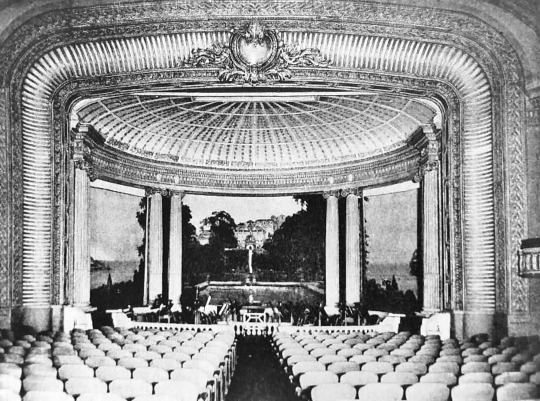
Such stage sets were often inserted for the performance of "prologues" or musical numbers before the movie screen would be lowered for the film showing.
As usual, interior photography is difficult without a tripod, and though some of these images are blurry, they give a good impression of what remains a stunning interior.
Sometimes thought of as a "companion" to the much larger Uptown theater just across Lawrence on Broadway, the Riviera was built first, and inspired the slightly later Chicago Theater in the Loop.
The purple wall color is not original, but there are no current plans to change it to the muted tones of the original scheme. A couple of original stencil designs have been uncovered in the lobbies, which will eventually be reproduced. The murals in the auditorium are faded and covered by grime and nicotine, but being backed by heavy paper rather than canvas, their restoration will prove tricky, and there is no current timeline for this process.
I was a bit mystified by the lack of theater seats on the main floor, which resembles a large concrete-floored nightclub rather than a theater. Never having been to a concert in this venue, I imagined what a standing-room crowd would experience here. the balcony level, however, has recently-installed theater seats, and seems a comfortable place from which to enjoy music.
The lobby features one of the original chandeliers from the Granada Theater in Rogers Park; somewhere there is a companion piece, which Jam hopes to acquire eventually for the outer lobby. The huge light fixture isn't exactly elegant; seen from the upper lobby, its design seems rather awkward. That, in my opinion, is one of the weaknesses of early movie palaces, which strove for an overall "wow" effect rather than architectural refinement or historical accuracy of detail.
Here are my photographs from my visit to the theater on October 14:
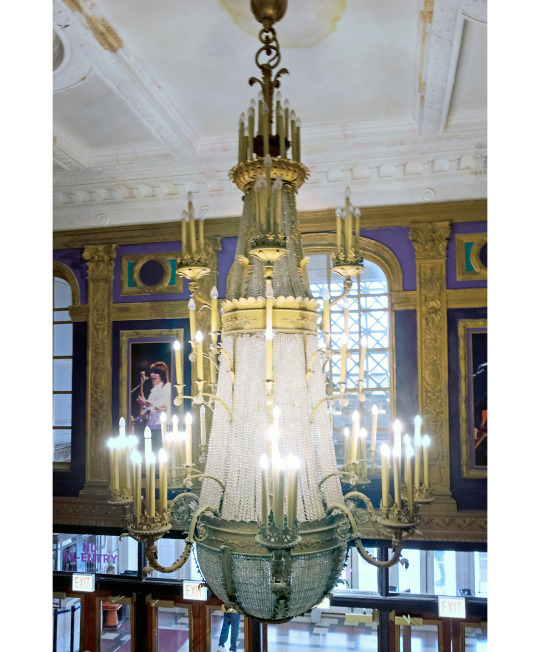
The Granada chandelier in the Riviera lobby

That's Chrissie Hynde
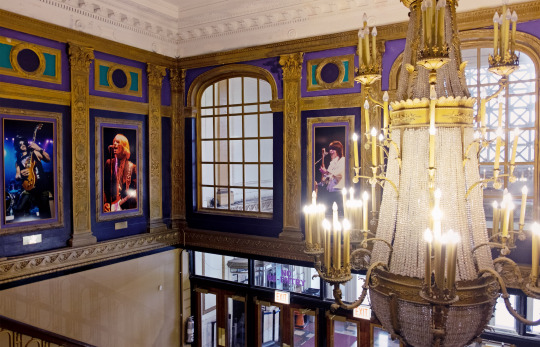






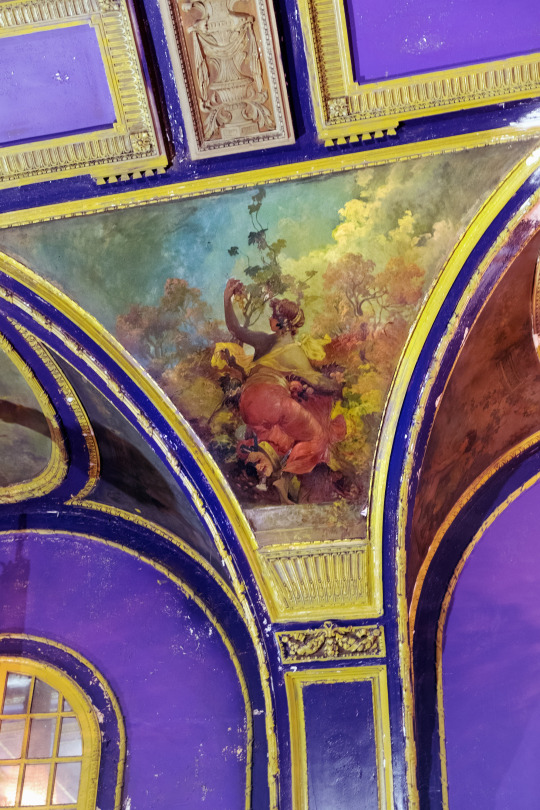
One of the depictions of the four seasons in the auditorium. The painting isn't nearly this clear or colorful; it's been Photoshopped. It appears muddy as in the next photo.
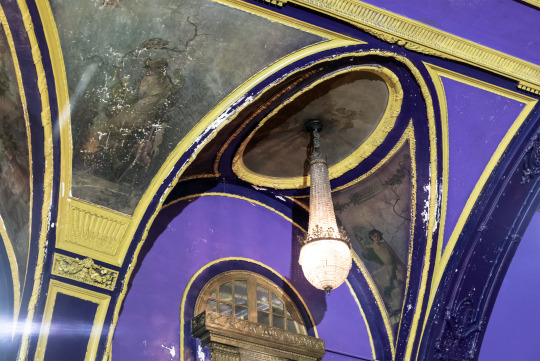
The six side light fixtures were later additions, and were simply hung from the center of the oval paintings.


#Chicago#architecture#movie theater#cinema#movie palace#Riviera Theater#Uptown#Open House Chicago#Rapp and Rapp#Balaban and Katz#Jam Productions
6 notes
·
View notes
Text

Flagship
Chicago Theatre - Chicago, IL
#photographers on tumblr#original photographers#chicago theatre#chicago#movies#theatre#light streaks#lighttrails#lights#citylights#nightlife#nightscape#nightlights#cityscape#cityscapephotography#historic architecture#historic buildings#balaban#katz#nightphotography
30 notes
·
View notes
Photo

🎭 The balaban and katz Chicago theater like we knew it (at Chicago Theater State Str) https://www.instagram.com/p/CiF46vNqEDG/?igshid=NGJjMDIxMWI=
0 notes
Photo










World Theater Day
The theater has been one of the most popular forms of entertainment since the Greeks, and the acting industry today is a hard but potentially prosperous career. If you have ever been in theater or seen a live show, you know how fun theater can be. It may seem like a dying industry due to the movie industry taking its role, but for those who love the art of theater, then you should know about World Theater day! Let’s find out about this special holiday and celebrate it!
Learn about World Theater Day
World Theater Day has been created to pay tribute to this incredible form of entertainment. People have enjoyed going to the theater for many years now. It is a great way to spend time with loved ones and to witness live entertainment. There is just something magical about the theater, isn’t there?
History of World Theater Day
Initiated in 1961 by the International theater Institute (ITI), each year theaters across the world celebrate the value and importance of theater, and this holiday acts as a wake-up call for governments, politicians, and institutions to see its value to society and for economic growth. ITI also host a yearly message, spoken by a chosen famous theater performer, to share their reflections on the art of theater and its future. The first of those messages were spoken by Jean Cocteau in 1962.
This message is translated into over 50 languages, read for thousands of spectators, and printed in hundreds of newspapers. It also spreads the message by broadcast to all corners of the world through their institutions. Because ITI has over 90 centers throughout the world, the institute also encourages colleges, schools, and theater professionals to celebrate this holiday as well.
The date of this holiday also corresponds with the opening of the Theater of Nations season in Paris. The goals of this holiday, according to ITI, is to promote theater in all corners of the world, bring awareness to the value of theater in all its forms, to help promote local theater communities on a broader scale, and to share the love of theater with others.
How to Celebrate World Theater Day
While many of the celebrations happen at ITI locations, it doesn’t mean you can’t join them. You can contact and coordinate it with the ITI Centre or Cooperating Member in their country or region to participate. You can also read/hear the message of their chosen speaker and spread it across social media using the hashtag #worldtheaterday.
If you want to do something of your own, visit your local theater and support them by donating to their affiliated organizations and maybe buy tickets to see some of their hosted concerts. You can even join a theater program and learn music and acting in your local area. It’s lots of fun and you can even encourage your friends to join in on the action and make it a group activity.
One show that we recommend is Top Hat. If you can’t watch it at a theater near you, you can always watch the film! Irving Berlin is deemed one of the greatest ever songwriters in American history by a lot of people. The composer and lyricist lived a long and colourful life and the world was lucky enough to be blessed by his phenomenal talent.
When he passed away in 1989, at the grand age of 101, his legacy certainly did not die. Many still celebrate his achievements today and there is no better example of this then Top Hat the Musical. Top Hat the Musical achieved massive success. A lot of this success has derived from the incorporation of Berlin’s music. After all, he did write the original songs that were incorporated in the 1935 original film featuring Fred Astaire and Ginger Rodgers.
In fact, this is deemed to be one of his most notable and loved works. Two of the songs – ‘Cheek to Cheek’ and ‘Top Hat, White Tie and Tails’ – are now considered to be American classics. If you are looking for a great sing-a-long you are assured to love the musical version of Top Hat. It doesn’t matter whether you have seen the original or not. And don’t worry; the show is not merely about songs, the plot is fantastic and really funny too!
Or, what about We Will Rock You? One of the main reasons why this show created such a buzz is because of the fact that it incorporates an array of well-known and well-loved Queen songs. This is what immediately draws people to go to see the musical in the first place. Yet, once the reviews started pouring in people discovered that there was a lot more to this show than having a sing-a-long to the hits from the world-famous rock band.
And so those who are not even a fan of Queen started to go and see the show and they were as equally as impressed as the biggest Queen admirers were. Belting out iconic tunes by Freddie Mercury and co is by no means an easy challenge. Yet the cast does it to perfection. They have embodied the big anthem feel that Queen has with all of their songs and they manage to get the whole theaters and arenas rocking. When taking on such massive songs quite often it is easy to fall short, but it’s definitely not the case when it comes to this rocking musical.
And finally, for those of you who think talent shows are ruining the music industry, you will definitely love the plot of this show. It follows a world whereby rock has been killed and commercialized pop music runs riot. Many would say that we are not far off from this happening in the current day. Yet, it’s unlikely that all humans will have ID cards rather than names anytime soon – as they do in the musical.
Source
#D. Maria II National Theatre#Lisbon#Lisboa#Portugal#World Theater Day#WorldTheatreDay#27 March#architecture#cityscape#travel#vacation#original photography#Second Stage Theater#New York City#USA#Canada#Richard Sweasey Theater#Eureka#Balaban and Katz Chicago Theatre#Capitol Theatre#Salt Lake City#Paramount Theatre#Toronto#Elgin and Winter Garden Theatres#Metropolitan Opera House#Lincoln Center#Strand Theatre#Riviera Theatre#Charleston
5 notes
·
View notes
Text
Is This Safe?
Each theatre is a marvel of design and engineering. Building a sound structure is only part of the equation. Architects must also factor in the stress on certain areas when the theatre is at capacity, consider optimal sightlines, and craft an aesthetically pleasing building too. Balconies add another level (no pun intended) of complexity to the mix. In order to safely add them support posts were commonly used in their construction, but they could obscure sightlines or crowd exit lanes, as seen below.


At the end of the 19th century the concept of cantilever balconies were introduced to theatre construction. A cantilever balcony uses a rigid beam anchored only on one side that eliminates external support such as supporting columns. Thought to have been first introduced in British theatre design, one of the earliest known examples in America is the New Amsterdam Theatre in New York, which opened in 1903.
Architects Rapp & Rapp and the Balaban & Katz chain took the cantilever balcony several steps further with the construction of the Chicago theatre and other movie palaces. The entire capacity of the New Amsterdam auditorium is 1,702 seats, the Chicago theatre held nearly that in its balcony with 1,504 seats. The Chicago has a huge cavernous auditorium that is 7 stories tall with the stage measuring over 60 feet, it was said to be the largest movie palace at the time of its opening in 1921.

Seeing a balcony as large without supports must have been a jarring sight, surely they would collapse under its own weight, to say nothing of when it was full of people. Now they are commonplace, but imagine seeing one for the first time when you were used to columns holding them up. The load capacity of the balconies would have been calculated by the engineers, but how to assuage the public’s concern? One way to test the load capacities is with sandbags. It is speculated that Balaban & Katz saw these sandbag tests as a public relations opportunity and circulated photos of these tests to assure the public that the massive cantilever balconies in their theatres were indeed safe.
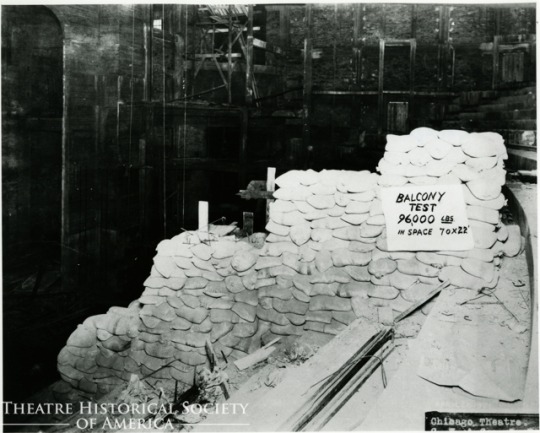

Above are sandbag test photos from the Chicago Theatre and the Southtown Theatre built by Rapp & Rapp in 1931 for Balaban & Katz
#Theatre Historical Society#American Theatre Architecture Archive#theatre history#theater history#movie theatres#movie theaters#Rapp & Rapp#rapp and rapp#Balaban and Katz#Balaban & Katz#chicago theatre#engineering#cantilever#balcony
26 notes
·
View notes
Video
“In the year 2025, the best men don't run for president, they run for their lives.” ―Stephen King
#Apple iPhone 8#Sauganash#Chicago#Illinois#IL#Windy City#Admiral Theatre#Vaudeville#1927#Gallup & Joy#Architects#Balaban & Katz#Gentleman's Club#Adult Entertainment#Historic#Classic#Design#Marquee#City#Urban#Street#Perspective#Dump Trump#Lord Dampnut#Mango Mussolini#Orange Nazi#Fascist Pig#Idiot in Chief#Trumpzilla
1 note
·
View note
Note
okay, i keep seeing you talk and post about it and i have to ask... what is eerie indiana and should i watch it? :))
what is Eerie, Indiana? Well. on a surface level Eerie Indiana is a family mystery show produced jointly by Hearst Entertainment and NBC in 1992. A show that the network was unable to properly advertise due to the 'tween' audience not yet being a thing it ended up being pit against 60 minutes (and in one case literally not even being aired at all so they could air the speech of a presidential hopeful /conspiracy theorist from jail, and another not being aired due to the network pulling it due to content, it was released by Fox in the 1998 reruns) essentially dooming it to fail. Despite this, NBC ordered a half season and a re-tooling of the show to introduce a more serialized set of storylines rather than episodic. Sadly, this wasn't enough to save the show and it was cancelled after one, single, glorious, practically perfect season in 1992, running for a mere 19 episodes.
Created by Jose Rivera and Karl Schafer (who most recently did Z Nation) the show is made up of immese talent at the very start of their career. I can't even tell you about the amount of talent on this oddball little show. Joe Dante (of Gremlins fame) directs and even acts in one episode. Bob Balaban directs some episodes, Claude Atkins plays a ghost cowboy, Anita Morris plays a sexy secret agent, Ray Walston plays an alien (i mean. duh.), René Auberjonois plays a literal devil business man named 'The Donald', Tobey Maguire (your beloved) plays a ghost who haunts Marshall and makes his family say slurs, Vincent Schiavelli plays an evil dentist, Future Scream Queen Danielle Harris plays a heart transplant recipient...The twist? The heart came from one of Marshall's best friends. and, best of all, John Astin (THEE JOHN ASTIN. GOMEZ ADDAMS) plays the mysterious owner/operator of The World 'O Stuff - the local hangout - for the final six episodes. Like the talent here is truly unreal. (did I mention John Astin?)
with a cast headed by Omri Katz (who you might know from Hocus Pocus) the plot of the show follows the adventures of Marshall Teller (Katz), his best friend/kid sidekick Simon Holmes (Justin Shenkarrow , you might know as the voice of Harold in Hey Arnold) and in the last six episodes, his homoerotic nemesis Dash X (Jason Marsden, you might know him from his many iconic voice roles - notably Max in a Goofy Movie, and also as Thackery Binx in Hocus Pocus) an alien with no memory of his past. On the surface, Eerie is a normal if slightly the Burbs esque small town, but once you look a little closer you start to see...Some cracks. A cult of housewives sealing themselves and their families in giant tupperware so they don't age. A Mayor who sends young men up to wolf mountain to ensure low taxes and they...Don't come back. A mysterious Loyal Order of Corn who...Run Things. Marshall and Simon investigate their strange hometown and are literally Just Trying to Get Through This Bestie. In one episode, Marshall goes where lost items go. In another, his friend Steve's retainer starts picking up the traitorous thoughts of the local dog population.
Eerie is a cult classic in basically every sense of the world. After you've seen it, you can see it's fingerprints all over the 'kids with bikes' genre. Stranger Things, Gravity Falls, Goosebumps (the show) all of them owe a massive debt to Eerie Indiana. The show itself is massively intertextual. It references everything from little shop of horrors, to the Howling, to the Twilight Zone to the Fly. But you don't need to have that knowledge to enjoy it, Eerie is a family show. By that I mean it was created for viewing by the whole family, not specifically teens or adults only. If you like Round the Twist (predates Eerie by 4 years), than you'll like Eerie.
in 1998 there was a controversial reboot made in Canada staring Bill Switzler and Daniel Clark. It too only lasted a season. I love TOD but many hate it.
Lastly, should you watch it? YES! I recommend Eerie to everyone I know basically. It is a little dated in parts, and some of the themes are really heavy (Child abuse and neglect are very present, long running themes in many episodes - I actually agree that Broken Record should have been pulled from airing because i find the ending very upsetting) Marshall, our protagonist is a very sweet, empathetic teenage boy character who I NEVER saw on television when I was growing up in the era of the Dan Schnider mean spirited sitcom. He's sort of an asshole sometimes but hey - he's a teenager. Simon is just adorable and literally deserves the whole world. Dash X is very cool, mysterious, gay and totally unhinged. Every character on this show is written fantastically, there are no half hearted performances, everyone is selling it the entire time. I'm very fussy about television, but Eerie is a show that I think is genuinely nearly perfect. I almost am glad it was cancelled so no one had a chance to ruin it lol.
If you're interested (and I hope I've sold you) then you can buy it on youtube, basically. It was previously on Amazon Prime but isn't anymore sadly. You can pay through the nose for an expensive DVD set like I did or.....You can do the smart thing, google it and watch on like. Kisscartoon lmao. Eerie is a show I am so so passionate about so if you're interested PLEASE watch it and feel free to join in discussion here on the hellsite, or you can go to Dreamwidth (@froodlemonkey/@catschimericalcreations runs this and has a MASSIVE back catalogue of fics, art, meta, random twitter posts, scripts, even the first Eerie Fanfiction...which was published in a ZINE in the 90s! seriously if someone has ever said anything about eerie ever than Cat has catalogued it with her extensive, fantastical tagging system) or even discord but like yeah. Eerie is amazing and you should like totally watch it :)
7 notes
·
View notes
Text
The Whacky, Unforgettable Comedies of Paramount Pictures By Donald Liebenson
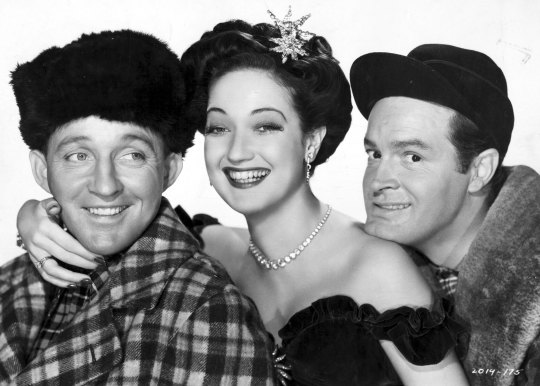
In Road to Utopia (‘45), Bob Hope and Bing Crosby are on the road again. “Case those trees, that snow, that scenery and that sky,” Bing exclaims as he and Bob sled across the Yukon. Noting a familiar-looking mountain, Bob adds, “And get a load of that bread and butter.” “That’s a mountain,” Bing corrects him. “May be a mountain to you, but it’s bread and butter to me,” insists Bob, as a semi-circle of stars materializes to arc the peak and recreate the Paramount Pictures logo.
Paramount was bread and butter to a murderer’s row of actors, entertainers and comedy teams who helped establish the studio as being to comedy what MGM was to musicals, Warner Bros. to gangster pictures and Universal to horror films. On January 26, TCM is offering up a mini-Paramount-palooza with three comedies and stars that defined their eras: I’m No Angel (‘33) starring Mae West; Road to Utopia with Bing Crosby and Bob Hope; and The Nutty Professor (‘63) starring Jerry Lewis in his signature Jekyll and Hyde role portraying the milquetoast, accident-prone Professor Kelp and self-described “world’s greatest everything,” Buddy Love.
Paramount comedies, especially of the 1930s and ‘40s, were the smartest, the silliest and the screwiest (and that’s only the s’s). Comedy was a priority for Paramount in the silent era, and once sound came in, the studio was uniquely positioned to sign the biggest comedy stars of Broadway, vaudeville and radio for shorts and features, according to Dr. Joseph Casper, an Alma and Alfred Hitchcock Professor of American Film at the University of Southern California.
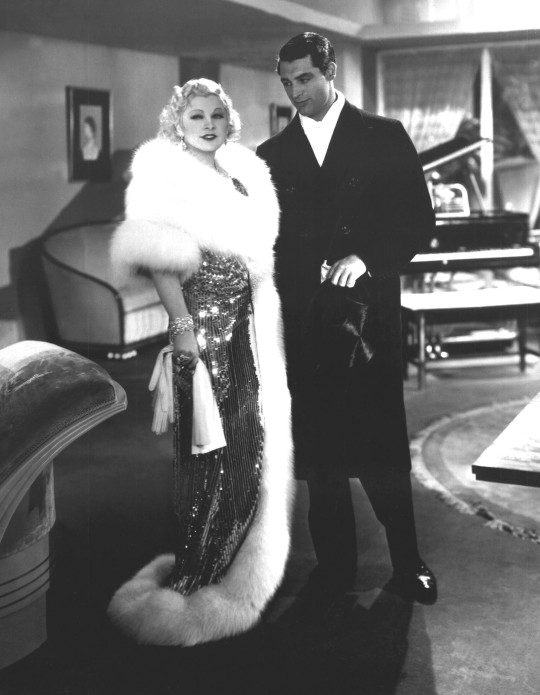
“Paramount owned most of the downtown theaters, including the Balaban and Katz chain, which was the largest circuit of first-run theaters,” he noted. “Those theaters featured movies and vaudeville entertainers. Paramount also had an interest in radio, and with its studio based in Astoria, NY, they could also see who was clicking with audiences on the Broadway stages.”
In addition to West, Hope and Crosby and Lewis, here is only a partial list of the comedy icons in Paramount’s stable: W. C. Fields, the Marx Brothers, George Burns and Gracie Allen, Jack Benny, Eddie Cantor, George Jessel, Jack Oakie and Charlie Ruggles (and his frequent costar Mary Boland).
Mae West came to Paramount with a Broadway pedigree and a 10-day jail sentence as the writer and star of the then-scandalous play, Sex. She was only a supporting character in the George Raft vehicle, Night After Night (‘32), her screen debut, but she made an indelible first impression. As Mae saunters into a night club, the coat-check girl greets her with, “Goodness, what diamonds.” Without breaking her stride, West coos, “Goodness had nothing to do with it, dearie.” She stole everything but the cameras, as George Raft said afterward of his costar. Her first starring role in She Done Him Wrong (‘33) established her persona as a “sexual gangster,” as modern-day burlesque queen Dita Von Teese dubbed her in the recent documentary Dirty Blonde (2020). Its box-office success is credited with saving Paramount from bankruptcy. I’m No Angel, the follow-up, was an even bigger box-office hit.

What makes it Paramount? In pre-Code Hollywood, Paramount did not try to tame or censor the wild, wild West of moviemaking. “When I’m good, I’m very good,” she tells co-star Cary Grant. “When I’m bad, I’m better.” As Tira, a carnival dancer and lion tamer, West is bold and independent. She needs no man to bail her out of trouble. In I’m No Angel, she takes it upon herself to conduct a courtroom cross-examination to unapologetically defend her sullied reputation. No wonder that she, along with the Marx Brothers and W.C. Fields, were rediscovered and embraced by Vietnam War-era college students for whom West, with her subversive attitudes and flouting of authority and convention, was a kindred iconoclastic spirit.
Road to Utopia was the fourth, and arguably funniest, of the seven Road to… films. For the record, I rank them:
Utopia, Morocco (‘42), Bali (‘52), Rio (‘47), Zanzibar (‘41), Singapore (‘40) and Hong Kong (‘62). Yes, I rank Bali over Rio (I look forward to your comments). Utopia was a franchise-best at the box office.
What makes it Paramount? It’s everything you love in a Road film, plus humorist Robert Benchley wryly kibbitzing from the sidelines. The Oscar-nominated script contains some of the series’ best character-defining gags, such as the indelible moment when Hope, trying to pass himself off as a feared killer, saunters up to a bar, orders a lemonade and then quickly course-corrects, “In a dirty glass.”
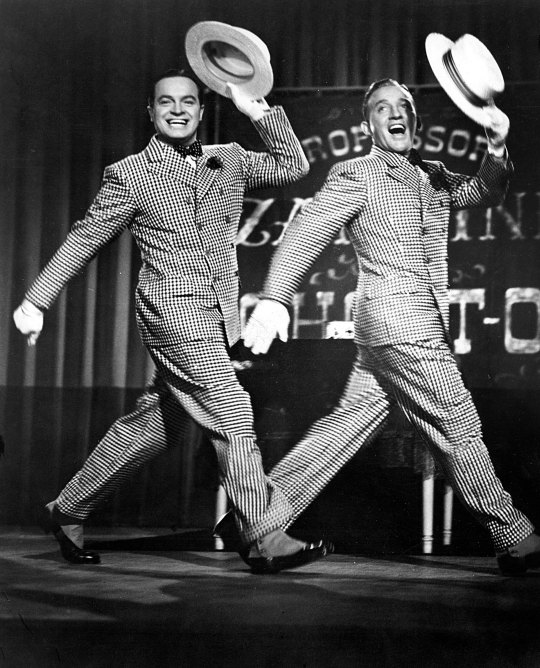
Road to Utopia is undistilled silliness with meta jokes (“I thought this was going to be an A picture,” Hope scowls when Crosby enters), fourth-wall breaking (“You mean they missed my song?” Crosby exclaims when informed that some in the audience might have come late to the movie theater) and talking animals (“A fish, they let talk,” a grizzly bear complains. “Me, they won’t give one stinking line.”). The closest Road to Utopia gets to pathos is when Hope and Crosby, about to go their separate ways, seemingly let their guards down and profess their undying friendship to each other… while picking each other’s pockets.
Even Jerry Lewis doubters concede him The Nutty Professor. With his former partner, Dean Martin, Lewis enjoyed a six-year Top 10 run at the box office beginning in 1951 until their acrimonious split in 1956. Paramount signed Lewis to an unprecedented contract in 1959 that earned him a reported $10 million, plus 60 percent of the profits and the film rights, to star in 14 films over a seven-year period. Though not embraced by the critics, Lewis was boffo, especially with kids, and he was in the box office Top 10 between 1957 and 1959 and from 1961 to 1963. And with his clout, he was given the freedom to grow as a director.

What makes it Paramount? More experimental and less flat-out funny than his previous slapstick offerings, The Nutty Professor earned Lewis uncharacteristically good reviews. It is generally considered to be his masterpiece, but that may be because people insist on interpreting Lewis’ portrayal of Buddy Love to be a caricature of his former partner. That may make this film more intriguing from a Freudian standpoint, but Lewis insisted throughout his life that he meant no such thing, and I believe him. Could be Frank Sinatra, though. Or even Lewis himself.
If you ever visit Paramount Pictures, opt for the four-hour studio tour. That gets you into the costume and prop archives, where costumes from The Nutty Professor and Road to Utopia are preserved. They are priceless relics of these first-class comedies whose absurd and anarchic spirit is undimmed, notes Randall Throop, manager of the department. You watch these and other Paramount comedies of the period, such as the surreal Million Dollar Legs (‘32) or the Marx Brothers classics, Throop ponders, “and you have to ask yourself: ‘What were they smoking?’”
#paramount pictures#Mae West#Road to Utopia#Bing Crosby#Jerry Lewis#comedy movies#TCM#turner classic movies#Donald Liebenson#Bob Hope
115 notes
·
View notes
Text
The Chicago Theatre




Louis Tomlinson World Tour 2022 Chicago
23.02.2022
This unofficial emblem of the city, known as the Balaban and Katz Chicago Theatre, was a movie theater enterprise. Currently, owned and managed by Madison Square Garden for stage plays, magic shows, comedy, speeches, sporting events and popular music concerts.
The 18 m wide by the six-story tall triumphal arch has been compared to the l'Arc de Triomphe in Paris. The central arch-headed window adapts the familiar motif of Borromini's false-perspective window reveals the top floor of Palazzo Barberini, Rome. The theater is also known for its grand Wurlitzer pipe organ
The capacity: 3.600
3 notes
·
View notes
Text
Chicago Theatre Celebrates 100th anniversary
Designed by architects Cornelius W. Rapp and George L. Rapp, the Chicago Theatre opened October 26, 1921, becoming the flagship of the Balaban and Katz chain.

Excerpts from Forest Leaves, November 10, 1921:
“The sixth Balaban & Katz theater-the Chicago-has made its appearance. It opened its doors to an anxious and curious crowd on last Wednesday at 6 o’clock in the evening.”
ABC Eyewitness News, October 26, 2021:
"The Chicago Theatre is celebrating its 100th anniversary Tuesday.
The marquee and the six-story-high sign have become Chicago landmarks and tourists often stop by to take photos.
The theater first opened as a dazzling movie palace that was part of the Balaban & Katz theater empire.
Silent films were shown along with full orchestras performing during the features.
The theatre was added to the National Register of Historic Places in 1976 and was listed as a Chicago Landmark in 1983."
Chicago Theatre
Historic Theatres and Movie Palaces of Balaban & Katz
Del Valle is the author of the Brooklyn Theatre Index, a three-volume history of borough theatres.
The first two chosen 2010 OUTSTANDING BOOK OF THE YEAR by the Theatre Historical Society. Final volume published in September 2014.
Editing and updating the third edition of the Brooklyn Theatre Index.
AboutMe
Goodreads
Medotcom
2 notes
·
View notes
Photo

Chicago Theater, August 2007
#chicago theater#movie palaces#chicago theaters#theaters#movie theaters#balaban and katz#theatres#2007#lumix dmc-fz20#bruce sharp
7 notes
·
View notes
Text
Lost Chicago Building 6 - The Granada Theater
By Roger Jones, August 2023

The Granada at night
I only saw a movie at the Granada Theater once, in the late 1970s; I believe the offering was Murder by Death. Nonetheless, I always marveled at the movie palace's facade every time the el train passed the Loyola stop on Chicago's north side.

Granada Theater from the CTA Loyola platform, found photograph, Flickr, probably 1970s

Granada marquee, c. 1930

The grand lobby in 1929
Historical details:
Opened: Tuesday, September 21, 1926
Status: Closed/Demolished Sunday, September 30, 1990
Style: Spanish Baroque
Seats: 3,443
The Granada Theater was a 3,400–seat movie palace located at 6427-41 North Sheridan Road, in the Rogers Park neighborhood of Chicago and adjacent to Loyola University. Constructed in 1926 for the Marks Brothers, major theatre operators in the U.S., Edward E. Eichenbaum was the principal designer for the architectural firm of Levy & Klein. Eichenbaum also designed the Marbro, Regal, and Century theaters in Chicago.
The Marks Brothers operated the theatre until 1934, when Balaban and Katz purchased the property. That firm and its successors—United Paramount Theatres, ABC Great States Theatres and Plitt Theatres—operated the facility until approximately 1978. From then until the mid-eighties, it was used sporadically for rock concerts and presented midnight showings of The Rocky Horror Picture Show for several years.
Despite all attempts to save the theater, Senior Life Styles Corporation purchased the property and demolished it in 1989-90 for a planned apartment/commercial structure.
The new 16–story apartment tower and shopping arcade constructed in 1991 was named "Granada Center.” Loyola University eventually purchased the structure and transformed it into 12 floors of student apartments over a base containing parking, retail and university offices.
Source: Wikipedia
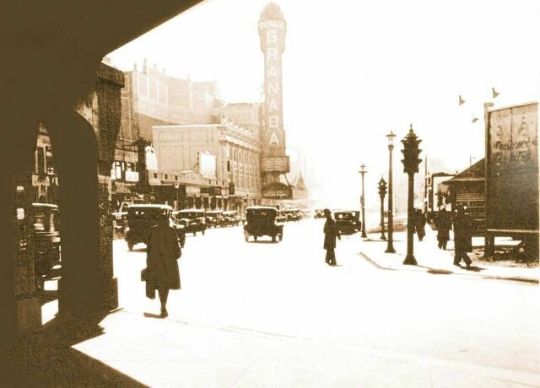
1920s photo, credit John G. Chuckman Collection
Following are scanned pages from The Chicago Movie Palaces of Balaban and Katz, by David Balaban:




Granada Theater under construction
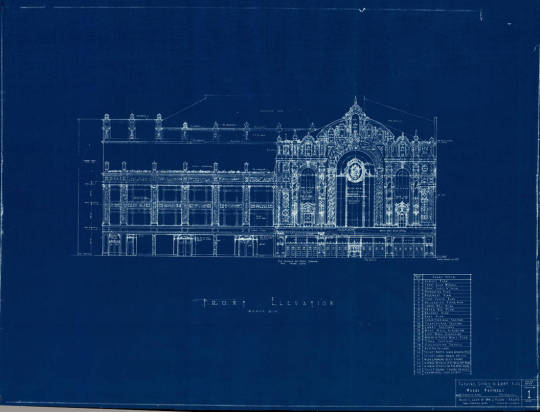
Architectural rendering, front elevation (no date)

Advertisement (no date)
Thanks to Cinema Treasures for the following details:
Built in 1926 for the Marks Brothers circuit, this was one of the largest movie palaces on Chicago’s Far North Side, located in Rogers Park. The Granada Theatre was opened September 18, 1926 with a Jack Haskell stage show “Eastern Nights” and on the screen Belle Bennett in “The Lilly”. The Wurlitzer 4 manual 20 rank theatre organ was opened by organist Alfred F. Brown The proscenium was 60ft wide and the stage 32ft deep. Seating was provided for 3,448, with 1,833 in the orchestra level and 1,615 seats in the balcony.
On November 18, 1932, the theatre was acquired by the Publix/Balaban & Katz chain and it was briefly closed, reopening on July 29, 1933 with John Barrymore in “Reunion In Vienna” & Laurel & Hardy in “Me and My Pal”. The Granada Theatre was originally designed by Edward Eichenbaum (of the firm of Levy & Klein) for both live stage shows and movies, but by the 1940’s, was only showing films. On November 19, 1975 the World Premiere of Jack Nicholson in “One Flew Over the Cuckoo’s Nest” was held at the Granada Theatre, with Jack Nicholson & Louise Fletcher appearing ‘in person’. It remained open as a movie theatre, operated by Plitt Theatres until the late-1970’s.
Information from the HABS Report on the Granada:
The report goes on to say that the primary reasons for the Granada’s historic significance include:
its size, as it was one of the three largest movie theatres ever built in Chicago, the other two being the Uptown and the Chicago theatres;
its elaborate design, often cited as the most ornate in the city;
its place as the flagship of the Marks Brothers empire, who were second only to Balaban and Katz in the construction and operation of opulent movie palaces; and
its association with architect Edward Eichenbaum.
Perhaps the most heartbreaking element of the HABS report is one of its closing statements: “The Granada had survived in essentially unaltered condition until the past two years (1988-89), when it was left unattended and the weather and vandalism were allowed to proceed unchecked.” This was a demolition that could have been avoided.
The HABS report included several dozen photos of the interior and exterior of the Granada Theatre, taken shortly before demolition. While it is depressing to see the damage the theatre suffered in its final two years, especially during a time when movie palaces across the country were being renovated to the benefit of communities large and small, these photos do show in great detail the artistry of Edward Eichenbaum.
Source: Compass Rose Cultural Crossroads
In addition:
...the Granada was still in remarkably good shape as recently as 1987. While it was allowed to deteriorate after that, eyewitnesses to the demolition mourn the fact that there was little wrong with the theatre structurally, that it could, in fact, have been saved.
Despite efforts to landmark the theatre or get it reopened, the Granada’s fate was sealed. Much of the terra cotta of the facade was stripped and sold off, as were many of the interior decorative elements. One of the large chandeliers from the lobby was salvaged and now hangs in the Riviera Theatre. Another, smaller, chandelier hangs in the Music Box on Southport.
Source: Compass Rose Cultural Crossroads
Photographs from the HABS Report, Library of Congress:

VIEW OF BLOCK FROM NORTHWEST LOOKING SOUTHEAST, 1980s, N. Sheridan Road

MAIN LOBBY CEILING FROM GROUND LEVEL
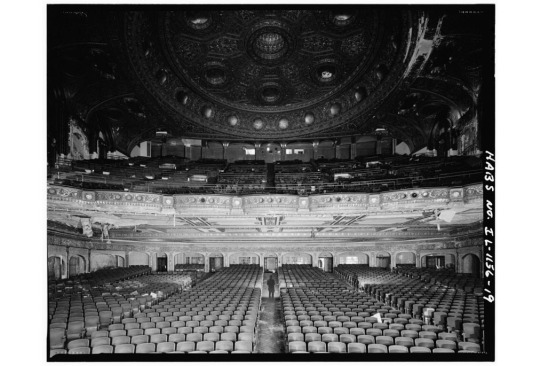
HORIZONTAL VIEW FROM STAGE LOOKING SOUTH

VIEW OF CEILING FROM STAGE

ALCOVE 2ND FLOOR LOBBY WALKWAY, during demolition

LOOKING EAST, VIEW OF COMMERCIAL OFFICE SECTION, NORTH PORTION OF THEATER COMPLEX
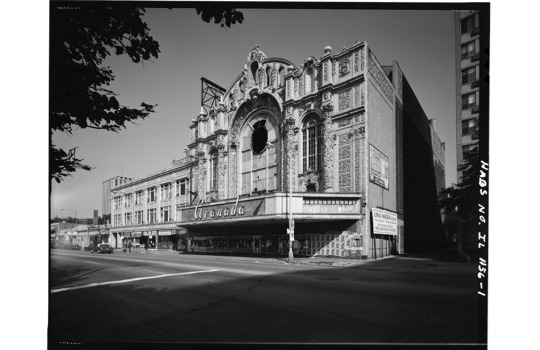
VIEW OF BLOCK FROM SOUTHWEST LOOKING NORTHWEST - during demolition
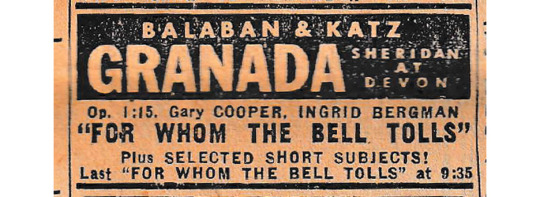
Admission ticket
Photos during the theater's destruction can be viewed in the Flickr set by Genial23 Ruined and abandoned.

A final view: Granada Theater, 1920s - Cinema Treasures, photo by Chicago Architectural Photographing Company
An incredibly detailed description of the building can be found on Historic Structures.
Today:

"Completed in 1991, Granada Center hosts residential apartments, a parking garage, office space for Loyola University, and several store fronts. The Center was built to help aid the growth and development of the Rogers Park neighborhood, as well as to provide more space for Loyola University." Loyola University Chicago Digital Special Collections
Finally, if you're interested in fragments, view the Urban Remains site for some interesting pieces of the Granada Theater.
#Granada Theater#Chicago#movie palace#Balaban and Katz#architecture#terra cotta#Edward E. Eichenbaum#Marks Brothers#cinema#Rogers Park#lost buildings
3 notes
·
View notes
Text
“Even though I didn’t feel myself up to trading quips with the likes of Noel Coward, the world into which Martin brought me was one I had always longed to be part of. Neil’s world, although it had been involved with entertainment, was really the business world, It might just as well have been involved with real estate, for it dealt with the financial end of the motion picture industry and certainly didn’t include writers, directors and actors except on a very superficial level. But such people were the main core of Martin's world, and he used to tease me by saying, `If it weren't for me you'd still be hanging around with Balaban and Katz.´
Even my parents were impressed with my new friends, especially my mother, who was as goggle-eyed as a child when it came to celebrities. Their attitude toward my marriage softened considerably when they saw how happy I was, and as time went along and they came to know Martin better, they did a complete abou—face. Martin and my father developed a healthy mutual respect, an affection even, for each other. As for my mother, she became so attached to him that one would have thought she had always been his staunchest friend and ally. And after my father became ill, and most especially after his death, my mother turned to Martin for all judgments, regarding him in fact as the Rock of Gibraltar, as compared to her flibbertigibbet daughter who wouldn't have sense enough to wear her rubbers if Martin wasn’t there to remind her.“
p. 70 f., Arlene Francis, A Memoir by Arlene Francis
3 notes
·
View notes
Photo

The Balaban & Katz United Artists Theatre, Chicago, Illinois, Vivian Maier, 1961
#photography#vintage#vintage photography#vivian maier#1960s#street photography#black and white photography#chicago#illinois#women artists#female artists#american#1961#100 notes
119 notes
·
View notes
Photo




The Chicago Theatre opened on October 26, 1921.
#Chicago Theatre#opened#26 October 1921#100th anniversary#US history#the Loop#architecture#cityscape#neon sign#original photography#travel#vacation#exterior#façade#Illinois#Chicago#Rapp & Rapp#Midwestern USA#Balaban and Katz Chicago Theatre#Great Lakes Region#175 North State Street#tourist attraction#landmark
8 notes
·
View notes